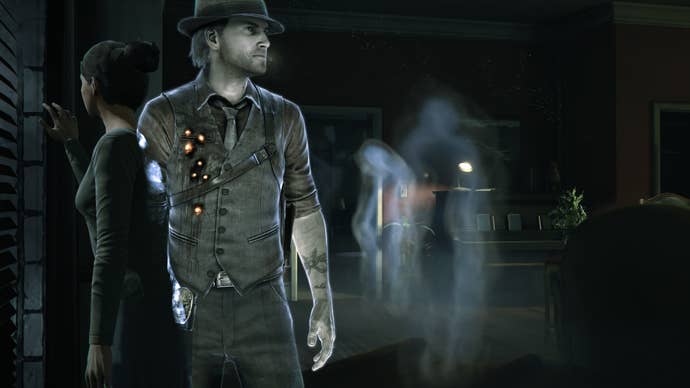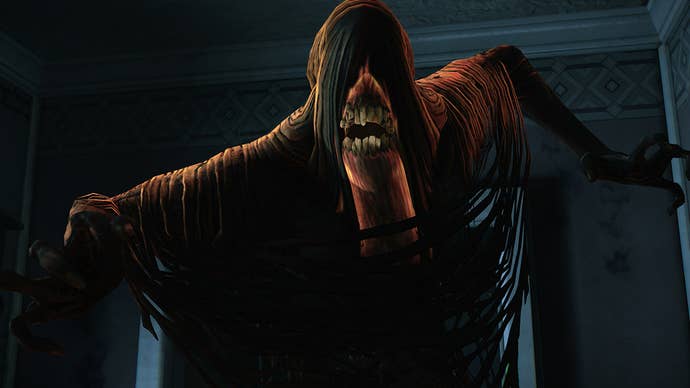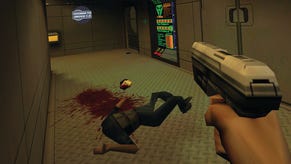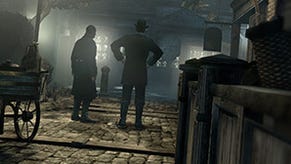Murdered: Soul Suspect Features a Deceptively Intriguing Premise
How Square Enix's new adventure game tackles the design problems that come with being a ghost.
This article first appeared on USgamer, a partner publication of VG247. Some content, such as this article, has been migrated to VG247 for posterity after USgamer's closure - but it has not been edited or further vetted by the VG247 team.
Though it sounds vaguely cliche and unoriginal – it's almost identical to the premise behind the 2011 Nintendo DS adventure game Ghost Trick: Phantom Detective, for instance – being a ghost is actually not an idea that has been seen a whole lot in gaming. The last game I can recall trying something similar is Geist, an ambitious effort that was nevertheless roundly panned back in 2005. The reason it's not seen much is simple: It's really hard to pull off in a first or third-person video game.
That's because unlike movies and television, games generally must lay down a certain set of rules and mechanics or else the world will fly apart. For instance, a ghost should be able to walk through any wall; but of course, that's not really possible in a game. Thus, any third-person ghost game with even a modicum of exploration must come up with in-universe explanations for limiting the ghost to certain areas. Either that or they can abandon all attempts at subtlety and simply erect a bunch of invisible force fields.
In grappling with those issues, Soul Suspect comes up with surprisingly successful solutions. It offers more freedom than you might expect, with relatively few concessions, even going so far as to open up the town of Salem for exploration following the opening tutorial. Of course, it also sneaks in little in-universe explanations for your inherent limitations as a video game ghost. You can't just enter any building you want, for instance, because they are consecrated and therefore inaccessible. Or if the game wants you to stick around and continue investigating a particular scene, the hero Ronan O'Connor will hesitate before going through the exit and mutter something about not being finished yet.

Those limitations aside, Soul Suspect does a good job of building an interesting world from the perspective of a ghost. Inside the apartment building that follows from the game's first scene, the walls seem to throb with ectoplasmic goo – the main indicator that it's possible to pass through a certain wall – and spirits wander mournfully through corridors before vanishing. Walk through a wall, and you may come across a bunch of twenty-somethings playing cards; possess one of them and you'll hear him quietly pining for the girl next to him. In that, Soul Suspect tells a million little stories, which does much to establish the feeling that you are peering in on a living, breathing world.
Of course, it's not perfect. As much as the world feels real and interesting, the actual puzzles feel clunky and mechanical. To clear an area, Ronan must poke around for clues. Occasionally that means possessing an onlooker and listening to their thoughts or peeking in on a notebook; but most of the time it entails methodically combing a room looking for evidence that can trigger the next section of the investigation. Once you have enough clues, you can make a "deduction" by choosing the piece of evidence that correctly fits the answer to questions like, "What was the girl doing?"
As puzzle-solving goes it's not tremendously novel or exciting, which is disappointing in a game that is kind of crying out to unmoor itself from gaming conventions. They mostly get the job done though, with abilities like being able to possess witnesses and jog their memories tying in decently with the overarching premise. Much more worrisome are the stealth sections. From time to time you will run into what are effectively Dementors from Harry Potter – soul-sucking demons that lurk around corners and near stairwells. The only way to destroy them is to wait until their back is turned before running in and activating a quick time event. As action sequences go, it's weird, jarring, and completely disrupts the flow of the gameplay and the atmosphere.

Yet you can understand why they're there. Remember Ghost with Patrick Swayze? Soul Suspect's ersatz dementors serve much the same purpose as the demons that drag poor stupid Carl Bruner into the underworld – they make the spirit world seem even spookier than it already is. Disappointingly, Soul Suspect's dementors can be defeated with the spirit equivalent of a karate chop to the back of the neck, making them more a mundane obstacle than a menacing demon. It's probably too late to completely overhaul the mechanics, but Soul Suspect might have been better served by taking the Resident Evil 3: Nemesis approach, making the dementor a terrifying force of nature that periodically pops up to pursue you through the streets, alleys, and corridors of Salem.
As it is though, Soul Suspect thus far does a credible job of crafting a relatively open adventure game without sacrificing the things that are interesting about being a ghost like walking through walls and possessing people. At the moment, it seems to be on track to being a solid B-tier effort – the sort of game that you pick up for $5 or $10 at a Steam sale and enjoy wholeheartedly. Should Airtight Games figure out what to do with the stealth sections, kick the puzzles up another notch, and shore up the frame rate in the cutscenes, it could even go up to the next level and become legitimately great. For now, it has the benefit of being unique, which isn't something that can't be said for a whole lot of regular retail releases. As you would expect from a ghost, it could well end up surprising you.??
















